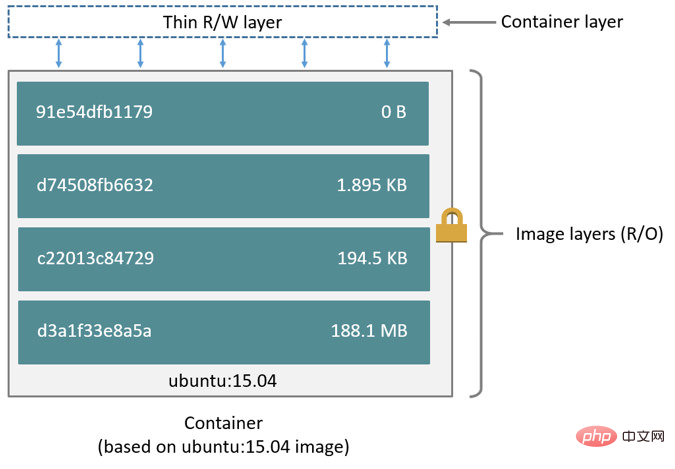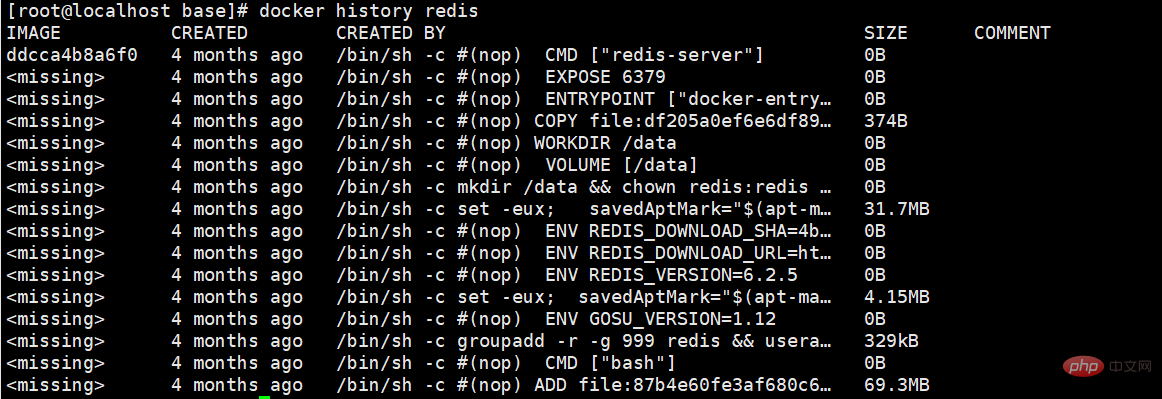 Operation and Maintenance
Operation and Maintenance
 Docker
Docker
 You can learn the idea of layered reuse with Docker in ten minutes
You can learn the idea of layered reuse with Docker in ten minutes
You can learn the idea of layered reuse with Docker in ten minutes
This article brings you issues related to image layering, container layering and the disk space occupied by containers in Docker. I hope it will be helpful to you.

How Docker organizes storage
Dokcer cleverly applies the idea of hierarchical reuse when organizing storage content. So we can use this as a case to learn this idea.
1. Image layering
A Docker image is divided into many layers during the construction process, and each layer is read-only. Let’s illustrate with the following example:
# syntax=docker/dockerfile:1 FROM ubuntu:18.04 LABEL org.opencontainers.image.authors="org@example.com" COPY . /app RUN make /app RUN rm -r $HOME/.cache CMD python /app/app.py
There will be 4 instructions in this Dockerfile that change the file system and create a new layer. The
-
FROMcommand creates the base layer from the ubuntu:18.04 image. -
LABELThe command only modifies the metadata of the image and does not create a new layer. The -
COPYcommand adds the contents of the current directory where this build is executed to the image, and creates a new layer to record the changes. - The first
RUNinstruction builds the program and outputs the results to the image, creating a new layer to record the changes. - The second
RUNcommand deletes the cache directory and creates a new layer to record the changes. The -
CMDdirective defines the instructions to be run in the container. It only modifies the metadata of the image and does not create a new layer.
Here each layer only records the differences from the previous layer. When we create a container, a writable layer is created, also called the container layer. Changes to the contents of running containers are recorded in this layer. The following figure describes this relationship:

2. Container layering
The main difference between containers and images is the top-level The write layer is different. All write operations to the container will be recorded in this layer. If the container is deleted, the writable layer will also be deleted, but the image will be retained.
Note: If you want multiple containers to share the same data, you can use Docker Volumes.
Each container has its own writable layer, where all transformations will be stored, so multiple containers can share the same image. The following figure describes this relationship:

Note: There is another detail here. Multiple mirrors may share the same layer, such as two mirrors. If the same layer is found locally when building or pulling, it will not be built or pulled again. Therefore, when calculating the image size, you cannot just sum up the size displayed by the docker images command. The value may be greater than the actual value.
3. The space occupied by the container on the disk
You can use the docker ps -s command to see the space occupied by the running container. (partial value). The different contents represented by the two columns:
- size: The disk size occupied by the container’s writable layer
- virtual size: Includes the size of the container’s writable layer and read-only image .
Other ways in which containers occupy disk space:
- Log files generated by containers.
- Contents mounted using Volume and bind mounts.
- Container configuration file
- Contents in memory (if swapping is enabled)
- Checkpoints (if this function is used)
4.Copy-on-Write (CoW) strategy
The storage drivers in Docker all use this strategy.
CoW strategy can share and copy files with maximum efficiency. If a file exists in a lower layer of the image, then its upper layer (including the writable layer) needs to read the content and can use the file directly. When it needs to be modified, the file is copied to this layer and modified. This minimizes IO and the size of each subsequent layer.
4.1 Sharing makes the image smaller
When we use docker pull to pull the image or use an image that is not available locally to create a container , the image will be hierarchically stored in the local Dockers storage area. In Linux it is usually /var/lib/docker.
We can go to the /var/lib/docker/<storage-driver></storage-driver> directory to see that we have pulled the images of each layer. For example, use overlay2 storage driver.

With so many layers, we can use docker image inspect to see which layers a certain image contains
docker image inspect --format "{{json .RootFS.Layers}}" redis
docker image inspect --format "{{json .RootFS.Layers}}" mysql:5.7

Through the above review, we can see that redis and mysql5.7 use the same layer. Sharing the same layer greatly saves the storage image space and also improves the pull. The speed of mirroring.
我们可以通过 docker image history命令来查看镜像分层情况,以redis为例
docker history redis

注意 :
有些步骤的大小为0,是因为他们只改变了元数据,并不会产生新层,也不会占用额外的空间(除元数据本身)。所以上述redis镜像中包含了5层。
-
<missing></missing>步骤,这些步骤可能是以下情况中的一种- 在另一个系统上构建的
- 从Docker Hub中提取的
- 使用BuildKit作为构建器构建的。
4.2复制让容器更有效率
当我们启动一个容器的时候,会添加一个可写层在镜像之上,用于存储所有的变化。当对已有文件进行修改的时候采用CoW策略。首先会到各层寻找到该文件,然后复制该文件到可写层,然后进行修改并存储。
这么做能够让我们最大限度地减少I/O操作。
但是,很明显的是当一个容器中的应用需要进行频繁的写操作,那么会造成可写层越来越庞大,此时我们可以通过Volume来帮助我们分担压力。
容器的元数据和日志是单独存放的,一般是存放在 /var/lib/docker/containers中,我们可以使用 du -sh /var/lib/docker/containers/*来查看各个容器占用多少。(容器ID其实就是文件夹名称的前12位)。

推荐学习:《docker视频教程》
The above is the detailed content of You can learn the idea of layered reuse with Docker in ten minutes. For more information, please follow other related articles on the PHP Chinese website!

Hot AI Tools

Undresser.AI Undress
AI-powered app for creating realistic nude photos

AI Clothes Remover
Online AI tool for removing clothes from photos.

Undress AI Tool
Undress images for free

Clothoff.io
AI clothes remover

AI Hentai Generator
Generate AI Hentai for free.

Hot Article

Hot Tools

Notepad++7.3.1
Easy-to-use and free code editor

SublimeText3 Chinese version
Chinese version, very easy to use

Zend Studio 13.0.1
Powerful PHP integrated development environment

Dreamweaver CS6
Visual web development tools

SublimeText3 Mac version
God-level code editing software (SublimeText3)

Hot Topics
 How to package project with pycharm
Apr 25, 2024 am 03:54 AM
How to package project with pycharm
Apr 25, 2024 am 03:54 AM
There are four ways to package a project in PyCharm: Package as a separate executable file: Export to EXE single file format. Packaged as an installer: Generate Setuptools Makefile and build. Package as a Docker image: specify an image name, adjust build options, and build. Package as a container: Specify the image to build, adjust runtime options, and start the container.
 Agile development and operation of PHP microservice containerization
May 08, 2024 pm 02:21 PM
Agile development and operation of PHP microservice containerization
May 08, 2024 pm 02:21 PM
Answer: PHP microservices are deployed with HelmCharts for agile development and containerized with DockerContainer for isolation and scalability. Detailed description: Use HelmCharts to automatically deploy PHP microservices to achieve agile development. Docker images allow for rapid iteration and version control of microservices. The DockerContainer standard isolates microservices, and Kubernetes manages the availability and scalability of the containers. Use Prometheus and Grafana to monitor microservice performance and health, and create alarms and automatic repair mechanisms.
 Pi Node Teaching: What is a Pi Node? How to install and set up Pi Node?
Mar 05, 2025 pm 05:57 PM
Pi Node Teaching: What is a Pi Node? How to install and set up Pi Node?
Mar 05, 2025 pm 05:57 PM
Detailed explanation and installation guide for PiNetwork nodes This article will introduce the PiNetwork ecosystem in detail - Pi nodes, a key role in the PiNetwork ecosystem, and provide complete steps for installation and configuration. After the launch of the PiNetwork blockchain test network, Pi nodes have become an important part of many pioneers actively participating in the testing, preparing for the upcoming main network release. If you don’t know PiNetwork yet, please refer to what is Picoin? What is the price for listing? Pi usage, mining and security analysis. What is PiNetwork? The PiNetwork project started in 2019 and owns its exclusive cryptocurrency Pi Coin. The project aims to create a one that everyone can participate
 Docker completes local deployment of LLama3 open source large model in three minutes
Apr 26, 2024 am 10:19 AM
Docker completes local deployment of LLama3 open source large model in three minutes
Apr 26, 2024 am 10:19 AM
Overview LLaMA-3 (LargeLanguageModelMetaAI3) is a large-scale open source generative artificial intelligence model developed by Meta Company. It has no major changes in model structure compared with the previous generation LLaMA-2. The LLaMA-3 model is divided into different scale versions, including small, medium and large, to suit different application needs and computing resources. The parameter size of small models is 8B, the parameter size of medium models is 70B, and the parameter size of large models reaches 400B. However, during training, the goal is to achieve multi-modal and multi-language functionality, and the results are expected to be comparable to GPT4/GPT4V. Install OllamaOllama is an open source large language model (LL
 How to install deepseek
Feb 19, 2025 pm 05:48 PM
How to install deepseek
Feb 19, 2025 pm 05:48 PM
There are many ways to install DeepSeek, including: compile from source (for experienced developers) using precompiled packages (for Windows users) using Docker containers (for most convenient, no need to worry about compatibility) No matter which method you choose, Please read the official documents carefully and prepare them fully to avoid unnecessary trouble.
 PHP distributed system architecture and practice
May 04, 2024 am 10:33 AM
PHP distributed system architecture and practice
May 04, 2024 am 10:33 AM
PHP distributed system architecture achieves scalability, performance, and fault tolerance by distributing different components across network-connected machines. The architecture includes application servers, message queues, databases, caches, and load balancers. The steps for migrating PHP applications to a distributed architecture include: Identifying service boundaries Selecting a message queue system Adopting a microservices framework Deployment to container management Service discovery
 How to optimize the performance of Java functions through containerization?
Apr 29, 2024 pm 03:09 PM
How to optimize the performance of Java functions through containerization?
Apr 29, 2024 pm 03:09 PM
Containerization improves Java function performance in the following ways: Resource isolation - ensuring an isolated computing environment and avoiding resource contention. Lightweight - takes up less system resources and improves runtime performance. Fast startup - reduces function execution delays. Consistency - Decouple applications and infrastructure to ensure consistent behavior across environments.
 Deploy JavaEE applications using Docker Containers
Jun 05, 2024 pm 08:29 PM
Deploy JavaEE applications using Docker Containers
Jun 05, 2024 pm 08:29 PM
Deploy Java EE applications using Docker containers: Create a Dockerfile to define the image, build the image, run the container and map the port, and then access the application in the browser. Sample JavaEE application: REST API interacts with database, accessible on localhost after deployment via Docker.





